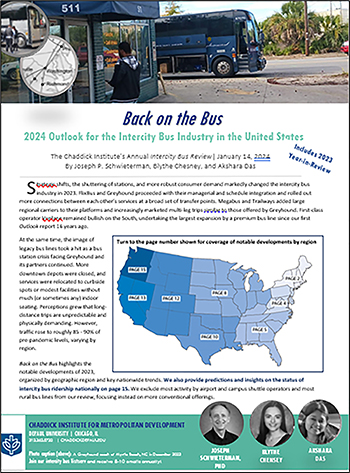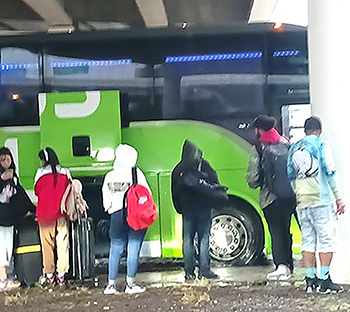
Finding an attractive option for an intercity bus trip in the United States became easier last year, a new DePaul University study shows. Many previously disconnected services have been brought together through new strategic initiatives and marketing alliances.
 “While searching for the best option still isn’t as easy as it is for plane and trips, bus lines are catching up,” noted Joe Schwieterman, a co-author of the DePaul study, Back on the Bus: 2024 Outlook for the Intercity Bus Industry reports. “The new schedule options that became available are giving a shot-in-the-arm to industry.”
“While searching for the best option still isn’t as easy as it is for plane and trips, bus lines are catching up,” noted Joe Schwieterman, a co-author of the DePaul study, Back on the Bus: 2024 Outlook for the Intercity Bus Industry reports. “The new schedule options that became available are giving a shot-in-the-arm to industry.”
Nearly all of the major brands made significant changes to their booking platform last year that give travelers many more itinerary options. FlixBus and Greyhound have centralized their management and planning activities. Multi-leg trips that involve connections between their services are now displayed among search results, resulting in more choices.
“A traveler can buy a ticket from Detroit, Michigan, to St. Louis that involves taking FlixBus on the first leg of the trip and Greyhound on the second,” Schwieterman said. Only a couple of years ago, Schwieterman notes, it was unclear whether FlixBus and Greyhound were committed to integrating their network in this way due to the different types of customers they serve.
“The integration has shortened wait times at many connecting points when transfers are required—something that travel-weary bus travelers no doubt welcome,” Schwieterman said.
The relocation of FlixBus service to the same stations as Greyhound in many major cities, including Atlanta, Boston, Chicago, Houston, Indianapolis, and Washington, is helping this effort. Plus, FlixBus and Greyhound customer policies have also been aligned, with each offering reserved seats and standard baggage rules.
Megabus and Trailways seem to revel in their underdog status when competing with FlixBus-Greyhound. Each gave their booking platforms a stronger national presence last year, with megabus.com adding Adirondack Trailway, Peter Pan, Salt Lake Express, and other lines to their reservation options. As a result, the megabus.com route map stretches almost from coast to coast, save for a gap between Denver and Salt Lake City. Megabus also began selling many more itineraries involving transfers between its buses. For example, passengers can now buy a Philadelphia – Charlotte ticket with a change of buses in Washington, DC. Trailways.com also added several prominent carriers, including Michigan-based Indian Trails. Many enhancements to booking platforms are supported by the Multi-Modal Cloud (MMC) system developed by Jacksonville, Florida-based Transcor Data Services.

Then January brought a big surprise: a new alliance between Trailways and FlixBus-Greyhound to put each other’s services onto their respective booking platforms. Numerous bus lines that had long been marketed separately will now be part of algorithms building connections for multi-leg trips.
“The alliance is excellent news, especially in the Northeast, where it will create many new itinerary options,” noted Schwieterman.
Metasearch travel websites, including busbud.com and wanderu.com are pivotal to making travelers aware of the new schedule options, allowing them to comparison shop, and providing customer support. These sites serve a role in bus travel akin to that of Travelocity in air travel and car rental. Wanderu.com, which celebrated its 10th-anniversary last year, partners with more than 500 bus companies and rail lines. Busbus.com specializes in intercity bus travel, working with several thousand companies worldwide.
 Legacy bus lines, however, continue to grapple with the closing of traditional Greyhound bus stations across the country, which had been particularly difficult in Knoxville, Tennessee; Little Rock, Arkansas; and Philadelphia, Pennsylvania.
Legacy bus lines, however, continue to grapple with the closing of traditional Greyhound bus stations across the country, which had been particularly difficult in Knoxville, Tennessee; Little Rock, Arkansas; and Philadelphia, Pennsylvania.
“Unfortunately, many public agencies, including transit lines, have turned a blind eye toward the sector,” Schwieterman said. “Some policymakers still fail to grasp that many of the same constituents who use local buses and trains also depend on long-distance bus services,” he remarked.
Intercity bus ridership across the country, the study estimates, has returned to around 85 – 90 percent of pre-pandemic levels, with a full recovery likely by 2026. Although the recovery will be uneven, with the Northeast Corridor continues lagging behind other regions, passengers are returning in large numbers.
To join the Chaddick Institute at DePaul University’s Intercity Bus Listserv or reach the study team, contact chaddick@depaul.edu.
